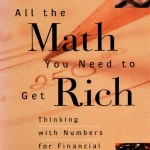Adding to a vast ocean of unrelenting bad news, let’s explore some troubling research into the fine print on Social Security benefits.
Andrew Biggs, a resident scholar of the American Enterprise Institute, has two papers out this Spring with interesting implications on our most important safety net for retirees.

One paper has bad news for a particular cohort of soon-to-be-retirees. The other explores an idea for helping with current financial distress. I personally think his proposal is wrong, but worth discussing.
Biggs wrote in a recent paper that for a group of soon-to-retire folks – specifically those born in the year 1960 – the COVID recession could be very hurtful to their benefits claimed in 2027, at full retirement age.
In his paper, Biggs assumes the 2020 US gross domestic product (GDP) shrinks by 15 percent in 2022, and that average wages also drop by a similar amount. The net effect of this drop in average wages – as a mathematical input into the Social Security benefits calculations for people born in 1960 in particular – will drop benefits by 13 percent overall. If that happens, for a medium-wage worker born in 1960 in particular, Biggs calculates an annual and ongoing hit of $3,900. For that same medium-wage worker, lifetime social security benefits drop by a present value of $70,193 due to the 2020 COVID effect.
The math justification behind Biggs’ claim isn’t obvious unless you enjoy building your own Social Security benefits spreadsheet.1
The math trick to know is that before calculating your first benefit check, Social Security indexes your annual earnings to a national wage index – rather than an inflation index, as you might expect.

If the wage index declines by 15 percent in 2020 (Biggs’ assumption), then this national wage indexing of 2020 earnings has a substantial negative impact on your benefit checks starting at age 67. Subsequent retiree benefit checks do increase according to inflation, known as the Cost of Living Adjustment. But if benefits start at a low base, for example, they will remain permanently lowered, even as they move upward with inflation over the years.
An economic recovery may mean later cohorts do not suffer this same temporary drop. Biggs recommends Congress consider interventions to protect this specific born-in-1960 cohort.
The COVID recession – depending on its duration and lasting effects on national wages – may also affect near-retirees born in 1961. So that’s your not-so-great news of the day on COVID.
Biggs also has written another paper in April 2020 which should be filed to the “interesting, but bad idea” pile. In the midst of our national discussions around stimulus payments, Biggs and his co-author Stanford Economist Joshua Rauh propose allowing pre-retirement individuals to take loans from their future Social Security benefits, which could be paid back at retirement age.
For context, private lenders do not make loans specifically collateralized by future social security payments. But Biggs and Rauh propose the federal government become that type of lender.
If a not-yet-retired individual decided to take a $5,000 check now, the authors suggest, the borrower could pay that loan back at retirement age by simply delaying owed benefits until the loan is repaid.
Part of the benefit to borrowers, Biggs and Rauh argue, is that the federal government could offer extremely low interest rates, knowing that it can recoup the money at the individual’s retirement date. This low interest rate helps the individual who could not otherwise borrow cheaply. In addition, warming the cockles of an economist’s heart, this cash infusion can be made budget neutral. Money paid out today during the crisis will be repaid, with low interest, by the worker at retirement.
In their scenario analysis, they show that most workers 45 or older who borrowed this way would likely only delay taking their social security benefits by three months, based on a $5,000 loan made today.
In simplest terms, Biggs proposes a mechanism for financially-strapped workers during the COVID recession to access their social security benefits early, with the obvious implication that they will have less later on, in retirement.
If enacted, (Narrator: this won’t be enacted) this form of pre-retirement loan would clearly impact the most vulnerable folks – people who have no other source of savings.
In general, I like considering any so-crazy-it’s-possibly-good wonky financial idea. But this is more like a so-crazy-its-possibly-terrible financial idea. I can’t endorse robbing future Peter to pay present Peter as a humane way to solve a short-term financial crisis.
When I am declared the National Personal Financial Benevolent Dictator (NPFBD) sometime in the future, I have a few different plans for Social Security. Different from both the current plan and Biggs’ suggestions.
My plan eliminates the need for complicated math and indexing as mentioned by the first Biggs paper. In my plan, basically, everyone gets the same amount of money. It doesn’t matter what your average 35 best earning years are, indexed for wages, then further adjusted for cost-of-living, then made progressive by counting different percentages of a specific workers’ earned wages. That’s a description of the current complicated math, simplified.

Instead, in my simple plan you get, say, $32,000 a year. Or whatever flat amount we choose. Everyone gets the same amount. No math. Congratulations, you’re 67. End of story.
If your lifestyle is above that cost, so be it. You should save some money now so you can maintain your lifestyle. If your lifestyle is below that cost, so be it. You’ll feel rich in retirement.
The complicated math we currently do for social security benefits is a very convoluted way to express a couple of wrong ideas. By wrong ideas, I specifically mean the ideas that:
1. We ‘earned’ our social benefits by a lifetime of working, and
2. If we worked more or harder or got paid more, then we should get a bigger chunk of cash in retirement.
I understand the implications of not doing any tailoring of benefits to individual workers and retirees. I understand why the current system feels “fair” to many. But I think the benefits of simplicity outweigh those implications, leading to a fairer outcome overall.
A spokesperson for the Dallas office of Social Security Katrina Bledsoe said they do not comment on projections or proposed policies, so declined to respond to my query about Biggs’ ideas.
Biggs responded to my query that he is very confident about the math behind his warning about the cohort of near-retirees born in 1960. His biggest doubt is whether the national wage index will actually fall by the estimated 15 percent – a sharp decline – or whether that’s too steep an assumption. At this point – not yet halfway through 2020 – we just don’t know yet.
A version of this post ran in the San Antonio Express News.
Please see related post:
Running for Personal Financial Benevolent Dictator
Building Your Own Social Security Spreadsheet
Building Your Own Social Security Spreadsheet, Part 2
Post read (95) times.
- Whoops, guilty as charged! ↩




